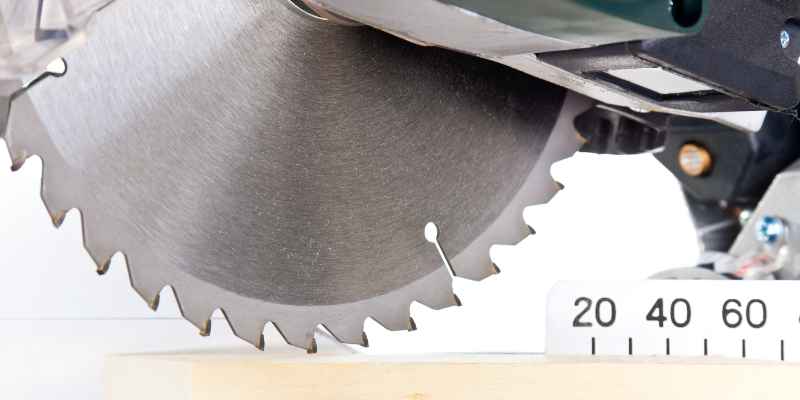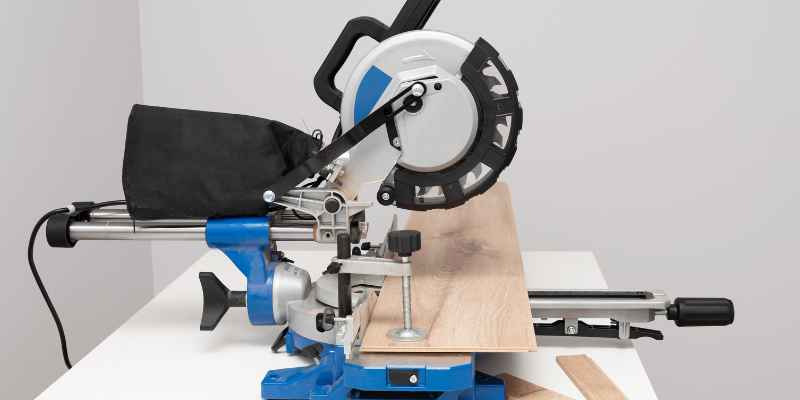When choosing a miter saw, there are two main types on the market: the 7.25″ and the 10″. Both have pros and cons, so it’s essential to know which is right for your needs before making a purchase. The 7.25″ miter saw is smaller and more lightweight than the 10″, making it easier to transport and maneuver.
It’s also less expensive, which makes it a good option for those on a budget. However, its smaller size means that it can’t handle large pieces of wood as quickly as the 10″, so keep that in mind if you’re planning on doing a lot of cutting. The 10″ miter saw is larger and heavier than the 7.25″, making it more challenging to move around.
It’s also more expensive, but its size allows it to handle more significant pieces of wood quickly and efficiently. If you need a powerful saw for big projects, the 10″ is probably your best bet.
There are many types of saws on the market, but the 7.25 miter saw and the ten miters saw are two of the most popular. Both have unique benefits that can make them ideal for different projects. So, which one should you choose?
The 7.25-miter saw is excellent for small projects or tight spaces. It’s lightweight and easy to maneuver, making it perfect for trim work or cutting smaller pieces of wood. The 10-miter saw is a bit bigger and heavier, but it’s still relatively portable.
It’s perfect for larger projects or working with thicker pieces of wood. So, which one is right for you? It depends on the project you’re working on and your personal preferences.
If you need a compact saw that’s easy to carry, go with the 7.25 miter saw. If you’re working on a more significant project or need to cut thicker pieces of wood, go with the 10-miter saw.

7 1/4 Sliding Miter Saw Cut Capacity
When looking for a miter saw, one of the main specs you’ll want to check is the cut capacity. The cut capacity is the maximum width or height the saw can cut through in a single pass. For example, a 10″ miter saw will have a maximum cutting width of 8″ (10 “-2”).
A 12″ miter saw will have a max cutting width of 10″ (12 “-2”). And so on. So what does this all mean for you?
Well, if you’re planning on doing a lot of broad cuts, you’ll need a saw with a large enough cut capacity to handle those cuts. On the other hand, if you mostly do thinner cuts, you can get away with a smaller saw. Keep in mind that the smaller the blade, the less power it has and the more limited its capabilities will be.
In general, most sliding miter saws have pretty good cut capacities. Even cheaper models can handle 8-9″ wide boards without problems. However, there are always exceptions, and some models are better than others.
So if you’re looking for a specific model, check its cut capacity before making your purchase.
7.25 Miter Saw
A miter saw is a handheld power tool used to make precise cuts in wood. The miter saw has a circular blade that pivots on an axis, allowing the user to make angled cuts. The most common use for a miter saw is cutting molding and trim for installation.
Miter saws can be powered by electricity or batteries, making them very versatile tools. They are also available in different sizes, from small handheld models to large stationary models. When choosing a miter saw, it is essential to consider the size of the project you will be working on and the type of material you will be cutting.
If you are looking for a powerful and versatile miter, saw, a 7.25-inch model is a great option. This size is large enough to handle most home improvement projects but small enough to maneuver easily. It also has plenty of power to cut through more rigid materials like hardwoods and composite decking.
10-Inch Sliding Compound Miter Saw Cut Capacity
A 10-inch sliding compound miter saw is a powerful tool to make quick, clean cuts in lumber and other materials. It’s essential to know the capabilities of your saw before you start using it, so you can be sure to get the best results. The cut capacity of a 10-inch sliding compound miter saw is 2-3/4 inches at 90 degrees and 2 inches at 45 degrees.
This means it can handle the most common lumber sizes without problems. However, if you’re planning on cutting more significant pieces of wood, you’ll need to consider a different saw. Always use sharp blades when making cuts with a sliding compound miter saw.
Dull blades will cause the saw to bind and can damage the material you’re trying to cut. If possible, use a carbide-tipped knife for the best results. These blades stay sharp longer and resist wear better than standard steel blades.
Your 10-inch sliding compound miter saw will provide years of service with proper care and maintenance. Be sure to read the owner’s manual carefully before using the saw so you understand its features and how to use them properly.
8 Or 10 Inch Mitre Saw
When it comes to miter saws, there are two main size options that you will encounter – 8 inches and 10 inches. Both sizes have advantages and disadvantages, so it’s essential to know which is suitable for the job before making your purchase. 8-inch miter saws are smaller and more lightweight than their 10-inch counterparts.
This makes them easier to transport and maneuver, especially when working in tight spaces. They also tend to be less expensive than larger models. However, they may not have the power or cutting capacity that you need for specific projects.
10-inch miter saws are more powerful and can handle tougher cuts. They are also typically more expensive than smaller models. But if you need a saw that can handle heavy-duty projects, a 10-inch model is probably the better option.
How Long Do Miter Saws Last
Miter saws are one of a woodworking shop’s most versatile and commonly used tools. They can be used for various tasks, from making clean cuts in molding and trim to creating angled cuts for picture frames. But how long do miter saws last?
The answer to this question depends on a few factors, including the quality of the saw and how often it is used. A well-made miter saw can last many years, while a cheap model may only last a few months. Using your miter saw regularly will inevitably wear out sooner than if it sits in your garage gathering dust.
That being said, there are ways to extend the life of your miter saw. Regular maintenance is essential, as is using suitable blades for cutting material. With proper care, your miter saw can provide years of faithful service.
12-Inch Sliding Miter Saw Cut Capacity
Most miter saws can handle cuts up to about 6 inches, but if you need to cut lumber 12 inches or wider, you’ll need a sliding miter saw. A sliding miter saw has a blade that slides on a track, allowing it to make much longer cuts than a standard miter saw. If you’re planning on doing any severe woodworking, a sliding miter saw is essential.
It can make quick work of cutting large boards and beams to size. And because the blade slides along a track, it can easily be long, precise cuts. There are a few things to remember when using a sliding miter saw.
First, because the blade moves back and forth on a track, it produces a lot of vibration and noise. Be sure to wear hearing protection when using this tool. Second, the blade can get very hot during extended use, so be careful not to touch it after making several cuts in succession.
Finally, always use caution when operating any power tool; following the manufacturer’s safety instructions will help ensure your devices’ safety and longevity.
What Size Miter Saw to Cut 2X4
When choosing a miter or saw, one of the most important factors to consider is the size of the blade. After all, the length of the edge will determine what types of cuts you can make and how many materials you can cut through. So, if you’re looking to cut 2x4s, what size miter saw should you choose?
Generally, a 10-inch miter saw will be your best bet for cutting 2x4s. This is because the blade on a 10-inch miter saw is large enough to handle the width of a 2×4 but not so large that it becomes unwieldy or difficult to control. Plus, with a 10-inch blade, you’ll be able to make all sorts of different cuts, including crosscuts, angle cuts, and more.
Of course, there are always exceptions to the rule, and there may be times when another size miter saw would be better suited for cutting 2x4s. For example, if you’re working with particularly long 2x4s, you might opt for a 12-inch miter saw instead. And if you know that you’ll only be making straight cuts, a smaller 8-inch miter saw could work just fine.
You must decide what size miter saw is best for cutting 2x4s based on your specific needs and preferences. But as a general guideline, we recommend going with a 10-inch model – it’s versatile enough for most projects and shouldn’t give you any trouble when cutting through those tough 2x4s.
Can a Miter Saw Cut a 2X10
When cutting lumber, a miter saw is one of the most versatile tools in your shop. With its quick, clean cuts and ability to handle a variety of materials, a miter saw can be an indispensable part of any woodworking project. So, can a miter saw cut a 2×10?
In short, yes! A miter saw can easily handle a 2×10 piece of lumber. Most miter saws are designed to cut lumber up to 12 inches wide.
So if you need to make a quick cut on a 2×10 piece of lumber, reach for your miter saw. Of course, there are always exceptions to the rule. If you’re working with particularly hard or thick lumber, you may need to use a different blade or take extra care when making your cuts.
But for the most part, cutting a 2×10 with a miter saw is no problem at all.
Will a 7 1 4 Miter Saw Cut a 4X4?
Yes, a 7 1/4 miter saw can cut a 4×4. The blade on a 7 1/4 miter saw is big enough to cut and has enough power to handle the thick piece of wood. Just be sure to use a sharp blade and take your time when cutting through a 4×4.
What Can a 7 1 4 Miter Saw Cut?
A miter saw is a powerful tool that can make quick, clean cuts in wood. It’s ideal for cutting molding, trim, and other small pieces of wood. The most common type of miter saw is the 7 1/4″ model. This size saw can cut through 2x4s and other lumber up to 6″ wide.
Miter saws are available in different sizes, but the 7 1/4″ size is the most popular because it’s versatile and can handle most projects. If you need to cut larger pieces of wood, you’ll need a larger miter saw. 10″ and 12″ models are available. Still, they’re more expensive and not as commonly used. No matter your size, the miter saw will have a blade that spins at high speed (usually between 3000 and 4000 RPM). The blade is mounted on an arm that swings back and forth to cut.
You can adjust the blade’s angle to make different cuts, including mitered (angled) and beveled cuts. To use a miter saw, start by setting up your work area. Make sure you have a stable surface to work on and enough room for the arm to swing without hitting anything nearby.
Place your wood on the table or surface so it’s supported at both ends (this will help prevent kickback). Next, select the appropriate blade for your project. For example, if you’re cutting softwood like pine or cedar, use a fine-toothed knife; if you’re cutting hardwood like oak or maple, use a coarse-toothed knife.
Once you’ve chosen the right blade, install it according to the manufacturer’s instructions (typically, this involves tightening two screws). Now you’re ready to start cutting! Position your hands, so one is on each side of the blade guard – never put your hand directly in front of or behind the spinning blade!
– and turn on the power switch. Slowly lower the blade into position against your piece of wood, then push down on the handle to start making your cut. Keep your hands close to the machine while it’s running; if something goes wrong or kickback occurs, you’ll want to be able to shut off quickly.
When you’re finished making your cut, release pressure on the handles, turn off the power switch, and wait for the blades to stop spinning before moving anything.

Is Bigger Mitre Saw Better Than Smaller One?
No definitive answer exists to this question as it depends on the specific saws in question and the preferences of the person using them. They are, generally speaking. However, giant miter saws tend to have more power and cutting capacity than smaller ones. They can also be more expensive, so weighing all factors before purchasing is essential.
Will a 7 1 4 Miter Saw Cut a 2X6?
If you’re looking to make a clean cut on a 2×6 with a miter saw, you’ll want to use a saw with at least an 8-1/2″ blade. A 7-1/4″ knife can technically cut, but it will be more complex, and the results won’t be as precise.
Conclusion
Two miter saws are commonly used in woodworking: the 7.25″ and the 10″. Both have advantages and disadvantages, so it’s essential to choose the right one for your needs. The 7.25″ miter saw is smaller and lighter than the 10″, making it easier to transport and maneuver.
It’s also less expensive, which makes it a good option for budget-minded shoppers. However, its smaller size means it can’t handle large pieces of wood as quickly as the 10″. The 10″ miter saw is more powerful than the 7.25″, making it better suited for heavy-duty projects.
It’s also more expensive, but its larger size makes it worth the investment for serious woodworkers.



3 thoughts on “Which Miter Saw Is Best For You? A Detailed Comparison Of 7.25 Vs 10 Inches”